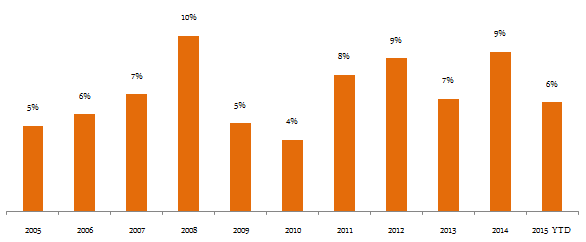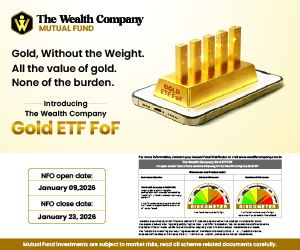Top 5 short term debt mutual funds in 2015

Debt mutual funds offer a large variety of products that cater to a wide spectrum of investment needs, risk profiles and interest rate scenarios. While bank fixed deposit is almost an automatic choice for most retail investors as far as short term or medium term low risk investment is concerned, over the past one year, fixed deposits interest rates have come down by 1%, making it challenging for investors who rely on fixed deposit interest as a source of income. On the other hand, if you look at the performance of debt mutual funds, you will see that across the entire range of investment tenures, mutual funds in different debt categories have given significantly higher post tax returns than fixed deposits. Fixed deposits are risk free investments with assured returns, while debt funds have an element of risk associated with it. However, it is important to understand that, risks involved in debt funds are very different from risks involved in equity funds. For example, the chart below shows the annual returns of short term income funds over the last 10 years.

Source: Morningstar
We can see that while the annual returns have fluctuated over the years, unlike equities, it has never been negative. Risk return characteristics of different types of debt funds are different. We have discussed the characteristics and suitability of different types of debt funds in our article, Demystifying debt mutual funds. As such, if you understand the risk return or characteristics of debt funds and you can make appropriate investment choices, you can get significantly higher returns on your short term to medium investments. In this blog, we will review Top 5 short term income funds. Short term income funds are good investment choices for conservative investors looking for stable income over an investment horizon of one to two years or maybe even longer.
Before we get to the top 5 short term income funds, let us review some important concepts related to debt funds.
Debt funds invest in fixed income securities, they employ two different kinds of investment strategy:-
Hold till Maturity:
This is also known as accrual strategy, by which the fund invests in certain types of fixed income securities (or bonds) and hold them till maturity of the bond, earning the interest offered by the bond over the maturity period. Interest rate risk in accrual strategy is quite low.Duration Calls:
Using this strategy the fund manager, takes a view on the trajectory of interest rates. Bond prices go up when interest rate falls and declines when interest rate goes up. When interest increases duration call strategy will give a lower return, and when they decrease the same strategy will give higher returns. This strategy involves interest rate risk.
Short term debt funds primarily employ hold to maturity or accrual strategy. Therefore interest rate risk of these funds is quite low. In addition to interest rate risk, debt funds can be exposed to another kind of risk known as credit risk. It is risk of default by the bond issuer, either with respect to interest payment or principal repayment or both. Credit rating agencies like CRISIL and ICRA in India rate fixed income securities based on their credit risk. Higher the credit rating, lower the yield but the risk is also lower. As we will see later in the blog, top short term income funds have excellent credit quality.
Let us now understand two other important concepts related to debt investments.
Yield to Maturity: Yield to maturity (YTM) is the return which the debt fund will get by holding the securities in its portfolio to maturity. For example if a debt fund’s portfolio has a YTM of 10% and a duration of 2 years, it means that, assuming no change to the portfolio, the fund employing accrual strategy will give 10% returns over the next two years.
Average Maturity: This is in simplest terms, is the average time period till all the fixed income securities in the fund’s portfolio matures and principal is repaid. During the maturity tenure, fixed income securities receive the interest payment, also known as coupon payments. Once you know the yield to maturity and average maturity of a debt fund, you can estimate how much income you can get, assuming no changes to the fund’s portfolio.
Top 5 Short Term Income Funds
Our selection of short term income funds is based on the most recent CRISIL ranking. CRISIL ranks short term debt funds based on several parameters like annualized returns, volatility, asset quality (exposure to credit risk), company concentration, modified duration, liquidity and exposure to sensitive sector. Each of the short term income funds in our selection has been assigned either Rank 1 or 2 by CRISIL. Further, in addition to CRISIL ranking, we have applied MORNINGSTAR rating as a secondary filter for our fund selection. The funds in our selection all have Morningstar rating of 4 stars, which was the cut-off in our selection methodology. Here are the top 5 short-term income funds selected using the discussed criteria, sorted on the basis of the last 1 year returns.

Source: Advisorkhoj Research
HDFC Medium Term Opportunities Fund: The scheme was launched in June 2010 and has र 4,082 crores of Assets under Management. The expense ratio of the fund is 0.28%. CRISIL has assigned Rank 2 for HDFC Medium Term Opportunities Fund, while Morningstar has given the scheme a 4 star rating. Over a one to three years investment period the fund gave in excess of 9% trailing annualized returns. The average maturity of the fund’s portfolio is 1.5 years and the yield to maturity (YTM) is 8.03%. In our view, for short term income funds, YTM is a better indicator of expected returns than historical returns. As discussed earlier a YTM of 8.03% and an average maturity of 1.5 years imply that, if you hold units of this scheme for 1.5 years, assuming no changes to fund portfolio, you can get a return of 8.03% before expenses are deducted. However, you should note that YTM is only an indicator, because there will be changes to fund portfolio. For example, there may be bonds maturing in fund portfolio during the investment period, which gets reinvested at different yields. The asset quality of the scheme is excellent with 88% of the scheme portfolio securities rated AAA. The scheme has an exit load of 1% for redemptions within 365 days.
Birla SL Short Term Fund: The scheme was launched in March 1997 and has र 9,557 crores of Assets under Management. The expense ratio of the fund is 0.28%. CRISIL has assigned Rank 1 for Birla SL Short Term Fund, while Morningstar has given the scheme a 4 star rating. One year trailing annualized return of the scheme is nearly 9%, while the three year trailing annualized return is 9.4%. The average maturity of the fund’s portfolio is 2.2 years and the yield to maturity (YTM) is 7.93%. The asset quality of the scheme is excellent with 86% of the scheme portfolio securities rated AAA. The scheme has no exit load.
Birla SL Treasury Optimizer Plan: The scheme was launched in April 2008 and has र 5,084 crores of Assets under Management. The expense ratio of the fund is 0.37%. CRISIL has assigned Rank 2 for Birla SL Treasury Optimizer Plan, while Morningstar has given the scheme a 4 star rating. One year trailing annualized return of the scheme is nearly 8.9%, while the three year trailing annualized return is 10.2%. The average maturity of the fund’s portfolio is 5 years and the yield to maturity (YTM) is 8.1%. Interest rate risk is limited. The asset quality of the scheme is excellent with 87% of the scheme portfolio securities rated AAA. The scheme has no exit load.
L&T Short Term Opportunities Fund: The scheme was launched in April 2008 and has र 1,681 crores of Assets under Management. The expense ratio of the fund at 0.8% is slightly on the higher side relative to the other top short term income funds. CRISIL has assigned Rank 1 for L&T Short Term Opportunities Fund, while Morningstar has given the scheme a 4 star rating. One year trailing annualized return of the scheme is nearly 8.2%, while the three year trailing annualized return is 8.9%. The average maturity of the fund’s portfolio is 2 years and the yield to maturity (YTM) is 8.1. The asset quality of the scheme is excellent with 96% of the scheme portfolio securities rated AAA. The scheme has an exit load of 0.5% for redemptions with 30 days.
IDFC Super Saver Income Fund - Medium Term: The scheme was launched in April 2008 and has र 1,681 crores of Assets under Management. The expense ratio of the fund is on the higher side at 1.2% on a relative basis. CRISIL has assigned Rank 2 for IDFC Super Saver Income Fund - Medium Term, while Morningstar has given the scheme a 4 star rating. One year trailing annualized return of the scheme is nearly 8.2%, while the three year trailing annualized return is 8.7%. The average maturity of the fund’s portfolio is 4.1 years and the yield to maturity (YTM) is 8.15. The asset quality of the scheme is excellent with 86% of the scheme portfolio securities rated AAA. The scheme has an exit load of 0.5% for redemptions with 90 days.
Taxation of Debt Funds
If units of debt mutual funds are redeemed within 36 months of purchase, then short term capital gains is calculated by subtracting the purchase cost from sales consideration. Short term capital gains is added to the income of the investor and taxed as per the income tax rate of the investor. If the units are redeemed after 36 months from the date of purchase then long term capital gains apply. Long term capital gains for debt mutual funds are calculated by subtracting the indexed cost of purchase from the sales consideration. The indexed cost of purchase is calculated by multiplying the actual cost of purchase with the ratio of cost of inflation index in the year of redemption and the year of purchase. Cost of inflation index table is published by the Reserve Bank of India and is available in the public domain. Long term capital gains for debt mutual funds are taxed at 20.6% (including education cess) after indexation.
Conclusion
When selecting short term income funds, investors should select schemes from fund houses with strong long term track record. You should also give due consideration to the AUM of the scheme and expense ratio, in addition to other considerations like asset quality, average maturity and YTM. Short term income funds can be excellent low risk investment choices for short to medium term investment periods. In this blog, we have reviewed the top 6 short term income funds. Investors should educate themselves about short term income funds and discuss with their financial advisors, if these are suitable choices for their financial planning needs.
Queries
-
What is the benefit of mutual fund STP
Aug 29, 2019
-
How much to invest to meet target amount of Rs 2 Crores
Aug 26, 2019
-
Can I achieve my financial goals with my current mutual fund investments
Aug 24, 2019
-
Can you tell me return of various indices
Aug 19, 2019
-
What would be the post tax return on different investments
Aug 18, 2019
-
Which Principal Mutual Fund scheme will be suitable for my retirement corpus
Aug 16, 2019
-
What is the minimum holding period for availing NCD interest
Aug 4, 2019
Top Performing Mutual Funds
Recommended Reading
Fund News
-
WhiteOak Capital Mutual Fund launches WhiteOak Capital Consumption Opportunities Fund
Jan 20, 2026 by Advisorkhoj Team
-
Shriram Mutual Fund launches Shriram Money Market Fund
Jan 19, 2026 by Advisorkhoj Team
-
PPFAS Mutual Fund launches Parag Parikh Large Cap Fund
Jan 19, 2026 by Advisorkhoj Team
-
Kotak Mahindra Mutual Fund launches Kotak Nifty200 Value 30 Index Fund
Jan 15, 2026 by Advisorkhoj Team
-
Bandhan Mutual Fund launches Bandhan Silver ETF FOF
Jan 12, 2026 by Advisorkhoj Team














